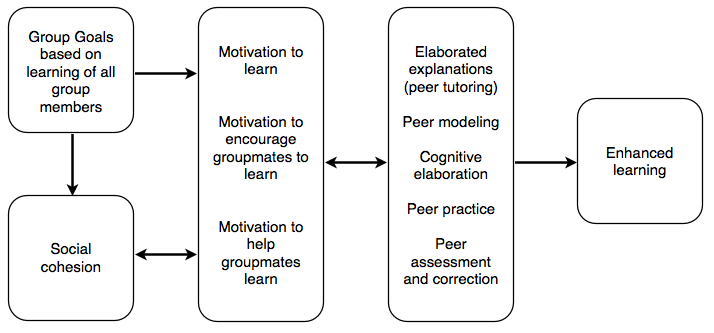Slavin’s (2011) integrated model of cooperative learning (Figure 7) is also foundational to understanding the study buddy activity and how it promotes social interaction and learning.
Figure 7. Slavin’s Integrated Model of Cooperative Learning
Based on student reports as well as knowledge of the structure of the study buddy activity, it appears that this activity aligns with Slavin’s model. From the outset, the activity featured group goals based on the learning of all members. In order for the activity to be successful, both partners had to be trustworthy to complete their work in submitting their assignments and feedback to their partner in a timely fashion. Social cohesion seemed to be the component of Slavin’s model with the most significant effect on the student experience, a finding supported by both the quantitative and qualitative analyses.
Slavin proposes three different motivational factors at work in cooperative learning environments: motivation to learn, motivation to encourage groupmates to learn, and motivation to help groupmates to learn. Of these three factors, the study buddy activity appeared to provide participants with motivation to learn as well as motivation to help groupmates to learn. Absent from these findings, at least explicitly, was the idea that the activity provided motivation for participants to encourage groupmates to learn (although this factor might be inferred from one participant’s report that his partner played a role in his decision not to drop the course.)
Slavin’s final group of factors relate to the cognitive restructuring effects of cooperative learning activities. As previously discussed, these effects seemed to be largely absent in this study. Slavin (2011) proposes that cognitive effects come about via elaborated explanations in peer tutoring situations, peer modeling, cognitive elaboration, peer practice, and peer assessment and correction. The study buddy activity works primarily through providing opportunity for participants to engage by assessing their partner’s work and providing corrective feedback which leads to the process of cognitive elaboration where the peer reviewer’s ideas are incorporated into the participant’s own mental models. Peer modeling may be happening in the background of the activity as good (or poor) study habits are demonstrated and passed along. The activity also serves as a kind of practice for the actual submission of the assignment to the instructor.
Given this close alignment with Slavin’s model, the study buddy should be considered a well-formed cooperative learning activity that promotes the acquisition of the intended learning outcomes.
